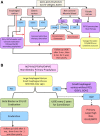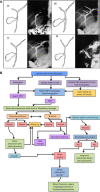Noncirrhotic portal hypertension: Medical and endoscopic management
- PMID: 31041002
- PMCID: PMC6490692
- DOI: 10.1002/cld.511
Noncirrhotic portal hypertension: Medical and endoscopic management
Figures



References
-
- Siramolpiwat S, Seijo S, Miquel R, Berzigotti A, Garcia‐Criado A, Darnell A, et al. Idiopathic portal hypertension: natural history and long‐term outcome. Hepatology 2014;59:2276‐2285. - PubMed
-
- de Franchis R. Evolving consensus in portal hypertension. Report of the Baveno IV consensus workshop on methodology of diagnosis and therapy in portal hypertension. J Hepatol 2005;43:167‐176. - PubMed
-
- Okuda K. Non‐cirrhotic portal hypertension versus idiopathic portal hypertension. J Gastroenterol Hepatol 2002;17(suppl 3):S204‐S213. - PubMed
-
- Verheij J, Schouten JN, Komuta M, Nevens F, Hansen BE, Janssen HL, et al. Histological features in western patients with idiopathic non‐cirrhotic portal hypertension. Histopathology 2013;62:1083‐1091. - PubMed
-
- Grimaldi C, de Ville de Goyet J, Nobili V. Portal hypertension in children. Clin Res Hepatol Gastroenterol 2012;36:260‐261. - PubMed
Publication types
LinkOut - more resources
Full Text Sources
Other Literature Sources

